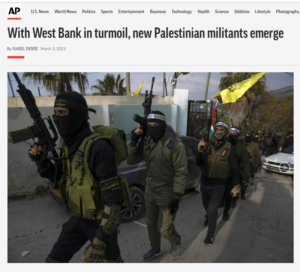“Sadly, in today’s media environment, when reporters say something is ‘new,’ it’s often merely new to them,” wrote Jonathan Schanzer and Joe Truzman of Foundation for the Defense of Democracies, explaining in the Washington Examiner “Why the West Bank is in chaos.” “Especially when Israel is involved, such narratives are reinforced by completely unrelated actions taken by the government that reporters find objectionable (judicial reform or settlement expansion, for example).”
Except for the fact that Isabel DeBre’s Associated Press article, “With West Bank in turmoil, new Palestinian militants emerge,” was published exactly one week after the Schanzer-Truman piece, one could reasonably conclude that they wrote those words specifically about her story.
Thus , her March 3 tale starring supposedly fresh recruits in a purportedly new militant group begins:
, her March 3 tale starring supposedly fresh recruits in a purportedly new militant group begins:
The stuttering blasts of M-16s shattered the quiet in a West Bank village, surrounded by barley fields and olive groves. Young Palestinian men in Jaba once wanted to farm, residents say, but now, more and more want to fight.
Last week, dozens of them, wearing balaclavas and brandishing rifles with photos of their dead comrades plastered on the clips, burst into a school playground — showcasing Jaba’s new militant group and paying tribute to its founder and another gunman who were killed in an Israeli military raid last month.
“I’d hate to make my parents cry,” said 28-year-old Yousef Hosni Hammour, a close friend of Ezzeddin Hamamrah, the group’s late founder. “But I’m ready to die a martyr.”
Similar scenes are playing out across the West Bank. From the northern Jenin refugee camp to the southern city of Hebron, small groups of disillusioned young Palestinians are taking up guns against Israel’s open-ended occupation, defying Palestinian political leaders whom they scorn as collaborators with Israel.
The Jabaa’ militants the author is referring to are established groups consisting mostly of Palestinian Islamic Jihad and al-Aqsa Martyrs Brigades members. These groups have been active since last year and are proscribed terror groups by many Western countries. https://t.co/HeomN9121o
— Joe Truzman (@JoeTruzman) March 8, 2023
By burying their current and previous affiliations, DeBre falsely paints the fighters as new recruits fresh off the barley fields and olive groves. She gives zero indication that the aforementioned Ezzeddin Hamamreh along with Amjad Khleleyah, who were killed by IDF return fire in January after the two opened fire on troops during an arrest raid, were Islamic Jihad fighters.

The mourning notice issued by the PIJ for the death of (left to right) Yazen al-Jabari, Hamamreh and Khleleyah (Daffa_media [the Telegram channel of the PIJ in the West Bank], Jan. 14, 2023)
As reported by the Meir Amit Intelligence and Terrorism Information Center:
The Palestinian Islamic Jihad (PIJ) issued a mourning notice stating the two were operatives in the Jerusalem Brigades, the organization’s military wing (PIJ website, January 14, 2023). The Jerusalem Brigades/Jaba squads issued a mourning notice stating that Khaliliya was in charge of its engineering unit (Jerusalem Brigades’ Jenin Battalion/Jaba squads Telegram channel, January 14, 2023).
Instead of reporting his Islamic Jihad membership, she misleads, only reporting that he received a gun from the terror organization. In addition, DeBre buries Hamamreh’s previous involvement in terror activity nearly 30 paragraphs down into her long story, stating:
Hamamrah, the Jaba group’s late commander, threw stones at the Israeli army as a teen and later joined an armed offshoot of Fatah, the party of Palestinian President Mahmoud Abbas, according to his mother, Lamia. After 10 agonizing months in Israeli prison, he became religious and withdrawn. He spoke of taking revenge.
After his death, Lamia discovered he had helped form the Jaba group and that Islamic Jihad had supplied them with weapons, including the gun Hamamrah fired at Israeli troops on Jan. 14.
The army chased him into Jaba, killing Hamamrah along with another gunman, Amjad Khleleyah.
Incidentally, Jaba and its allegedly “new” group of spontaneous militants is again in the news today, as gunmen fired (again) on Israeli troops carrying out an arrest raid. As the AP itself reports today:
The suspects opened fire on the Israeli troops, who shot back and killed three, all members of the Islamic Jihad militant group, police said. …
But it’s not only Israeli police who say that the three Jaba combatants killed today belonged to Islamic Jihad. As Haaretz reports:
According to the Israeli Border Police, two of the casualties, Ahmad Fashafsha (22) and Ismail Fakhoury (26) were Islamic Jihad operatives. The third causality, Nayef Malayshah (25), was identified as a “militant activist.” Islamic Jihad later claimed all three men as part of its Jaba’ Brigade, and said that they had regularly fired at Israeli forces.
Clearly, Islamic Jihad is running a brisk operation in Jaba. But DeBre enthusiastically labors to depict a “new” “militant” organization distinct from the well-established and officially designated terror organization. In her efforts to rebrand Islamic Jihad as something new, shiny and grassroots, she adds:
With fluid and overlapping affiliations, these groups have no clear ideology and operate independently of traditional chains of command — even if they receive support from established militant groups. Fighters from Palestinian Islamic Jihad and other organizations attended last week’s ceremony in Jaba.
Thus, she depicts PIJ as mere outside guests attending the main event of the supposedly independent, grassroots organization.
DeBre’s piece also perfectly aligns with the second part of the pattern that Schanzer-Truman identified: citing objectionable Israeli government behavior as responsible for the “new” Palestinian terror. Thus, she traces the emergence of the Jaba group to the rise of Israel’s new far-right government:
At least 15 Israelis have been killed in Palestinian attacks in that time, including two Israelis shot Sunday in the town of Hawara, just south of Jaba. In response, Israeli settlers torched dozens of buildings — a rampage that also left one Palestinian dead.
“It’s like the new government released the hands of soldiers and settlers, said now they can do whatever they want,” said Jamal Khalili, a member of Jaba’s local council.
At the recent memorial service, children with black militant bands on their foreheads gathered around the gunmen, eager for a glimpse of their heroes.
“The outcome is what you see here,” Khalili added.
Busting that faulty narrative, Schanzer and Truzman expertly trace the emergence of these types of organizations back to 2021, identifying that May as an inflection point:
By the end of 2021, however, armed clashes between Israeli forces and gunmen had become routine. So it behooves us to look for the turning point. We find it in May 2021 during an 11-day war between Israel and Hamas. Israeli security officials now say that Hamas made a strategic decision after that clash to abandon battles in Gaza because it is a territory the terrorist group already controls. Rather, it elected to export unrest and chaos to the West Bank, with assistance from Iran and some of its proxy groups, with the goal of taking it over. Stoking violence there has the benefit of threatening Israel and destabilizing the rival Palestinian Authority.
Another fundamental flaw with her story is the purported dichotomy of the new young fighters versus their old and supposedly pacificist leadership. “From the northern Jenin refugee camp to the southern city of Hebron, small groups of disillusioned young Palestinians are taking up guns against Israel’s open-ended occupation, defying Palestinian political leaders whom they scorn as collaborators with Israel,” she writes.
But the line between the two groups is not so solid as she would have us believe. According to a Meir Amit Intelligence and Terrorism Information Center report, membership within the cross-organizational squads across the West Bank is diverse: “Some of them are high-ranking officers in the PA’s security forces, some have no clear political affiliation, and some are operatives of the Palestinian security forces who have no organizational affiliation.”
“The violence in the West Bank and Israel is not new. Nor is it the result of Israel’s recent elections. The current narrative misses the real story,” Schanzer and Truzman concluded in the Washington Examiner. “Israel is actively working to counter the surge in terrorism, instigated by Iran-backed groups seeking to destabilize Palestinian Authority territory, with a persistently erroneous media narrative that only makes the job that much harder.”
For something really new, Isabel DeBre should check out the August 2022 interview with Hossein Salami, commander of Iran’s Revolutionary Guard Corps (IRGC). Then she might get the real story about what is happening today across the West Bank.
